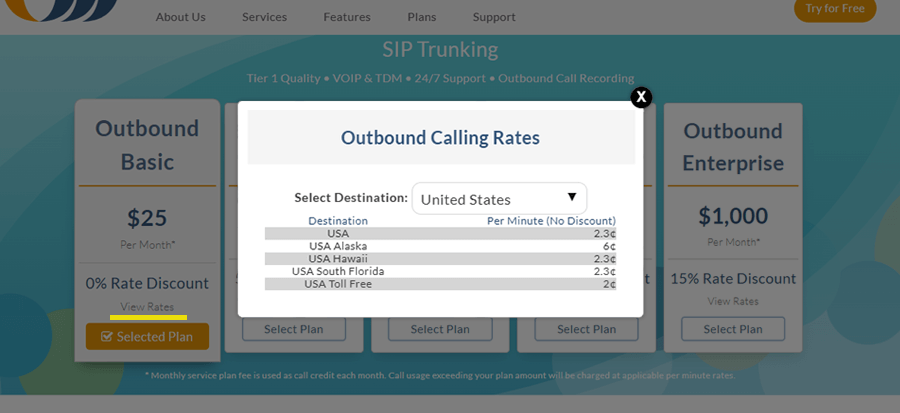SIP trunking offers a compelling alternative to traditional phone lines. Gone are the days of relying on expensive analog lines and calling fees for business communication. Why? Because SIP trunking uses your existing internet connection and communication hardware to transmit voice calls.
But this depends on finding the right SIP trunk provider. Once you’ve settled that, implementing and using this service is straightforward. SIP trunking integrates smoothly with your existing phone system.
In this guide, we’ll cover:
- What to Expect from a Global SIP Trunk Provider
- Benefits of Switching to SIP Trunking
- How to Choose the Right SIP Trunk Provider? 8 Factors to Keep in Mind
What to Expect from a Global SIP Trunk Provider
Instead of traditional phone lines, a SIP trunk service uses Session Initiation Protocol (SIP) to send voice calls on virtual phone lines. These lines allow for multiple calls to happen at the same time; i.e. a SIP trunk carries multiple SIP channels where 1 channel = 1 inbound/outbound call, allowing for multiple calls simultaneously.
A global SIP trunk provider can be your one-stop shop for international communication needs, with the tools needed for smooth global connectivity. By adding SIP trunks to your phone system, you can expect:
Efficient Call Handling
At its core, SIP trunking is a highly scalable and reliable phone system that can handle many conversations simultaneously without losing call quality or efficiency. This means that your business can stay connected even during peak times.
Global Coverage
And because it transmits calls virtually, your business can achieve global voice connectivity at a scalable rate. Simply tap into your provider’s network of virtual phone numbers from various countries. This way, you can count on receiving top-notch voice quality for incoming and outgoing calls worldwide.
International Termination
SIP trunk providers offer international SIP termination services that guarantee your calls reach their destinations without any hitches. SIP termination is the process of routing calls from one provider (usually the SIP provider) to another PSTN or VoIP provider. In simpler terms, you can use SIP trunks to make outbound calls to customers wherever they are located and connect comfortably to their PSTN or VoIP setup.
Easy Integration
SIP trunks easily integrate with your existing business phone system, whether hosted or on-premises. In most cases, setup takes hardly a few days.
Feature Sets
Many SIP trunking providers offer outbound features, such as SIP calling, local caller ID, and call masking. These features let you manage how your number appears to call recipients, thereby increasing call connection rates.
Benefits of Switching to SIP Trunking for Business
Everyone from small startups to global corporations embraces modern telephony’s advantages, such as SIP trunking. Here are the top 5 reasons why:
- As SIP trunking uses the internet to place calls, overall communication costs go down. Save costs on long-distance and international calls. This is because traditional long-distance calls may need to be routed through multiple carriers, driving up per-call costs. Additionally, SIP trunking eliminates the need for additional hardware and maintenance.
- You and your staff can make or receive calls from anywhere—all you need is a stable internet connection and SIP-enabled devices like phones, computers, tablets, etc.
- Easily scale your service up or down—add or remove phone lines and destinations—as your business needs change, all without the hassle of dealing with multiple contracts.
- Typically, service providers offer redundant connections and disaster recovery features, ensuring minimal downtime and business continuity in case of outages.
- Get features like advanced routing, caller ID management, and multiple other communication features on a single unified platform.

Learn more about how this communication technology can benefit your business in our SIP trunking guide.
How to Choose the Right SIP Trunk Provider?
Choosing the right SIP trunk provider is crucial for a smooth transition and reliable communication. Remember, the ideal provider understands your business and offers the right features at a reasonable cost.
Let’s evaluate the different factors to consider when choosing a SIP trunk provider for business communication.
Quick summary:
- Look for established providers with a proven track record.
- Beyond pricing, consider the features offered, customer reviews, and contract flexibility.
- Responsive customer support, ideally available 24/7 and through various channels, is essential for troubleshooting.
- A dedicated account manager can further ensure your needs are met. Research different providers, compare offerings, and don’t hesitate to contact them directly.
Free trials can also be a valuable tool.
1. Determine Communication Needs and Gaps
Before selecting a SIP trunk provider, assess your business’s communication requirements and scalability needs. For instance, consider:
- Call volume – how many calls need to be supported simultaneously?
- Team location – which teams and locations need to be added to the phone network?
- Features – are there any features or functionality currently missing that can help improve your inbound and outbound calling efforts?
- Tools like international phone numbers, softphone, local caller IDs, international call forwarding, etc.?
Cloud-based phone services provide a much more elastic telephony infrastructure. Unlike traditional analog lines, you can easily adjust channels, phone numbers, and destinations through a web interface. And with a global SIP trunk provider, you can expect extensive global coverage to support your international communications.
2. Identify Features and Functionality Needed
Consider the features and functionality essential for your business operations. Most cloud telephony and SIP trunk providers offer a full suite of inbound and outbound calling features. Of course, what your business needs depends on your size, team and customer location, call volume, and budget. But here are the features we’ve seen customers use the most:
Inbound features must-haves:
- International call forwarding
- Call routing strategies
- Call recording
- Virtual voicemail
- Transcription
- Online dashboard, etc.
Outbound features must-haves:
- Caller ID management
- Softphone for inbound and outbound calling
- Integrations, etc.
Another important factor: how easy is setup? How quickly can you get this new phone system up and running with little-to-no downtime?
Consider compatibility with your existing systems and evaluate ease of integration.
3. Research Providers and Their Offerings
When researching, look for SIP providers with global coverage, advanced features, flexible pricing plans, and positive customer reviews.
Reach out to representatives to gauge their responsiveness and see if you can use a free trial before subscribing to get a sense of the service.
Consider United World Telecom
Over 28 years, United World Telecom has partnered with Tier 1 carriers worldwide to bring businesses a high-quality SIP trunking solution at affordable rates.
Why choose United World Telecom?
- Global SIP trunk numbers in 160 countries
- Monthly plans — no long-term contracts
- International SIP termination
- Local caller ID management
- PBX integrations – 3CX, FreePBX, Genesys, Cisco, Mitel, Panasonic, etc.
- CRM integrations – Zoho, Zendesk, Salesforce, etc.
- High call quality
- No setup fees or long-term contracts
- Quick activation and dedicated account management
- Advanced features — call recording, time-based and location-based routing, voicemail translation, and more
- Scalability — easily add/remove users, phone lines, destinations, as needed.
4. Consider Costs
To make informed SIP trunking decisions, businesses must dissect cost structures. Monthly subscriptions can vary based on channels, virtual numbers, and even per-user fees. Outbound calling rates are another key element, with options for metered pay-as-you-go plans or predictable unmetered options. Don’t forget potential add-on costs for features like call recording. Finally, factor in any setup fees.
While pricing structures vary by provider, a careful evaluation of these cost factors and competitor comparisons will lead you to the most cost-effective SIP trunking solution that aligns with their communication needs and budget.
Here’s a breakdown of our SIP trunk pricing:
Monthly Subscription:
- Monthly fee for the phone number used as the caller ID for outbound calls. For example, US numbers start at $7.95.
- Monthly call credit; Basic plan is $25.
International Calling Rates:
- United World Telecom call rates are metered. Different countries have different calling rates and this gets deducted from the call credit.
- Calling rates can be found on our SIP trunk pricing guide.
Features & Add-ons:
- 40+ free features including Caller ID Management and Softphone.
- Premium features at additional rates such as Inbound or Outbound Call Recording for $5 monthly fee + 3¢ per minute.
Setup Fees or Contracts:
- No set up fees.
- Month-to-month billing; no long-term contracts.
Total SIP Trunk Pricing for United World Telecom: $7.95 monthly subscription + $25 call credit = $32.95 per month

5. Understand Setup and Requirements
You can quickly integrate SIP technology into your existing infrastructure with minimal hassle.
Ditch the setup headaches!
Service providers like United World Telecom handle everything for you. Get an outbound calling plan, and we’ll provide the SIP trunk credentials you need. Simply enter them into your phone system, and you’re ready to make calls.
6. Review Testimonials and Customer Reviews
Before making a decision, take advantage of the wealth of information available online. Researching customer reviews and testimonials will offer valuable insights into a SIP trunk provider’s track record and industry standing.
Ask providers for testimonials, references, and case studies. Positive reviews from satisfied customers can give you confidence in a provider’s ability to deliver on its promises.
7. Test Top Providers
Many SIP trunk providers offer free trials or demos, allowing you to experience their service firsthand. Make calls to various locations and devices to assess voice quality and stability. Play around with the features to determine how you may use them. See how user-friendly the provider’s control panel is for managing your settings. Most importantly, engage with their customer support team. Ask questions and evaluate their responsiveness and technical expertise.
In this way, you can take advantage of free trials and demos and eliminate any lingering doubts. And then confidently choose the SIP trunk provider that delivers the performance, reliability, and features you need.
Want to see how United World Telecom works? Book a demo today!
8. Review Security Measures and Compliance
Finally, security is always a concern for businesses and that should extend to communications networks as well. Look for providers adhering to industry-established security protocols like secure real-time transport protocol (SRTP). These standards encrypt communication content, making it unreadable even if intercepted.
Inquire about the provider’s security infrastructure. Reputable companies will have robust firewalls, intrusion detection systems, and access controls in place to prevent unauthorized access to your network.
Get Global SIP with United World Telecom
Sign up for SIP Trunking with United World Telecom. Not ready to take the plunge? Start with a free trial and test out our service. Get an outbound number and add inbound features.
Still have questions about how SIP trunking works? Our experts are here to help you make the right decision. Reach out to us to see if it is a good solution for your exact business communication needs.


